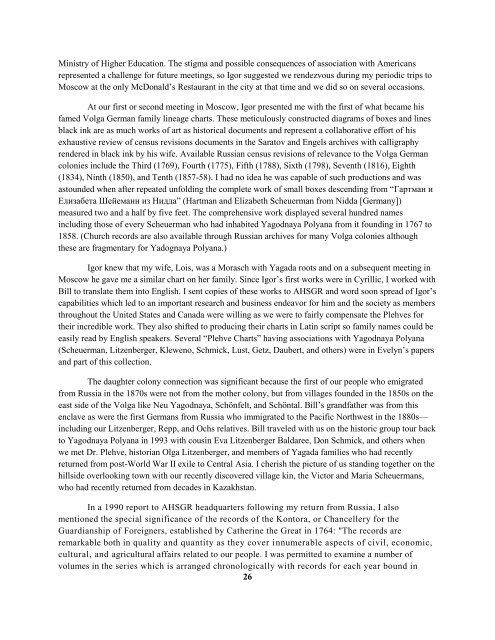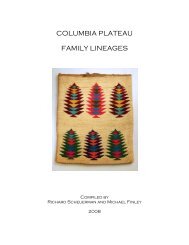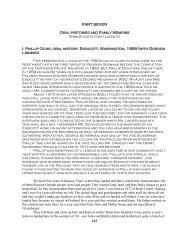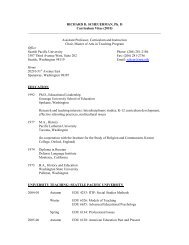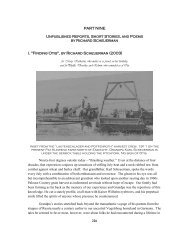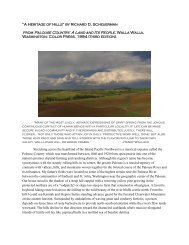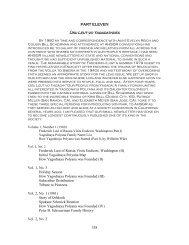THE BERRY MEADOW ARCHIVE - Mountain Light School
THE BERRY MEADOW ARCHIVE - Mountain Light School
THE BERRY MEADOW ARCHIVE - Mountain Light School
You also want an ePaper? Increase the reach of your titles
YUMPU automatically turns print PDFs into web optimized ePapers that Google loves.
Ministry of Higher Education. The stigma and possible consequences of association with Americans<br />
represented a challenge for future meetings, so Igor suggested we rendezvous during my periodic trips to<br />
Moscow at the only McDonald‟s Restaurant in the city at that time and we did so on several occasions.<br />
At our first or second meeting in Moscow, Igor presented me with the first of what became his<br />
famed Volga German family lineage charts. These meticulously constructed diagrams of boxes and lines<br />
black ink are as much works of art as historical documents and represent a collaborative effort of his<br />
exhaustive review of census revisions documents in the Saratov and Engels archives with calligraphy<br />
rendered in black ink by his wife. Available Russian census revisions of relevance to the Volga German<br />
colonies include the Third (1769), Fourth (1775), Fifth (1788), Sixth (1798), Seventh (1816), Eighth<br />
(1834), Ninth (1850), and Tenth (1857-58). I had no idea he was capable of such productions and was<br />
astounded when after repeated unfolding the complete work of small boxes descending from “Гартман и<br />
Елизабета Шейеманн из Нидда” (Hartman and Elizabeth Scheuerman from Nidda [Germany])<br />
measured two and a half by five feet. The comprehensive work displayed several hundred names<br />
including those of every Scheuerman who had inhabited Yagodnaya Polyana from it founding in 1767 to<br />
1858. (Church records are also available through Russian archives for many Volga colonies although<br />
these are fragmentary for Yadognaya Polyana.)<br />
Igor knew that my wife, Lois, was a Morasch with Yagada roots and on a subsequent meeting in<br />
Moscow he gave me a similar chart on her family. Since Igor‟s first works were in Cyrillic, I worked with<br />
Bill to translate them into English. I sent copies of these works to AHSGR and word soon spread of Igor‟s<br />
capabilities which led to an important research and business endeavor for him and the society as members<br />
throughout the United States and Canada were willing as we were to fairly compensate the Plehves for<br />
their incredible work. They also shifted to producing their charts in Latin script so family names could be<br />
easily read by English speakers. Several “Plehve Charts” having associations with Yagodnaya Polyana<br />
(Scheuerman, Litzenberger, Kleweno, Schmick, Lust, Getz, Daubert, and others) were in Evelyn‟s papers<br />
and part of this collection.<br />
The daughter colony connection was significant because the first of our people who emigrated<br />
from Russia in the 1870s were not from the mother colony, but from villages founded in the 1850s on the<br />
east side of the Volga like Neu Yagodnaya, Schönfelt, and Schöntal. Bill‟s grandfather was from this<br />
enclave as were the first Germans from Russia who immigrated to the Pacific Northwest in the 1880s—<br />
including our Litzenberger, Repp, and Ochs relatives. Bill traveled with us on the historic group tour back<br />
to Yagodnaya Polyana in 1993 with cousin Eva Litzenberger Baldaree, Don Schmick, and others when<br />
we met Dr. Plehve, historian Olga Litzenberger, and members of Yagada families who had recently<br />
returned from post-World War II exile to Central Asia. I cherish the picture of us standing together on the<br />
hillside overlooking town with our recently discovered village kin, the Victor and Maria Scheuermans,<br />
who had recently returned from decades in Kazakhstan.<br />
In a 1990 report to AHSGR headquarters following my return from Russia, I also<br />
mentioned the special significance of the records of the Kontora, or Chancellery for the<br />
Guardianship of Foreigners, established by Catherine the Great in 1764: "The records are<br />
remarkable both in quality and quantity as they cover innumerable aspects of civil, economic,<br />
cultural, and agricultural affairs related to our people. I was permitted to examine a number of<br />
volumes in the series which is arranged chronologically with records for each year bound in<br />
26


